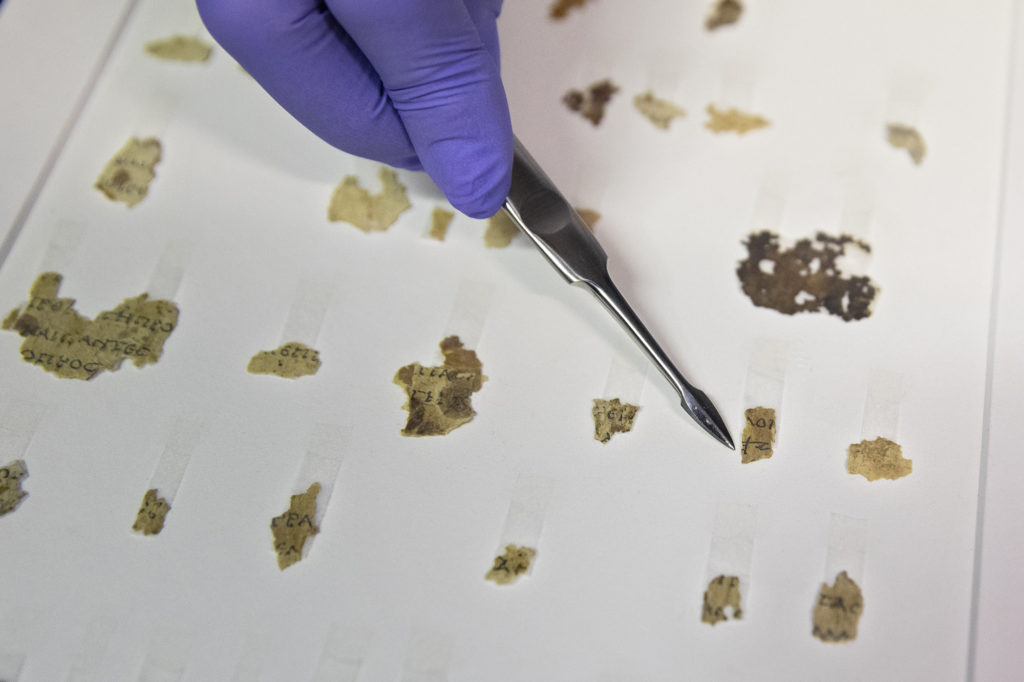
JERUSALEM (AP) — Israeli archaeologists on Tuesday announced the discovery of dozens of Dead Sea Scroll fragments bearing a biblical text found in a desert cave and believed hidden during a Jewish revolt against Rome nearly 1,900 years ago.
The fragments of parchment bear lines of Greek text from the books of Zechariah and Nahum and have been dated around the first century based on the writing style, according to the Israel Antiquities Authority. They are the first new scrolls found in archaeological excavations in the desert south of Jerusalem in 60 years.
“The new finds demonstrate the continued need for supporting biblical archaeology, for it is still our main source of any new information for the study of the biblical text,” Dan Warner told Baptist Press. Warner is a professor of Old Testament and archaeology at New Orleans Baptist Theological Seminary (NOBTS) and co-director of the Tel Hadid Excavation.
“Information like this is rare, so it’s highly prized to help understand the development and transmission of the Hebrew Bible,” he said.
The Dead Sea Scrolls, a collection of Jewish texts found in desert caves in the West Bank near Qumran in the 1940s and 1950s, date from the third century B.C. to the first century A.D. They include the earliest known copies of biblical texts and documents.
The roughly 80 new pieces are believed to belong to a set of parchment fragments found in a site in southern Israel known as the “Cave of Horror” – named for the 40 human skeletons found there during excavations in the 1960s – that also bear a Greek rendition of the Twelve Minor Prophets, a book in the Hebrew Bible. The cave is located in a remote canyon around 25 miles south of Jerusalem.
According to Dennis Cole, professor of Old Testament and archaeology and co-director of the Moskaw Institute of Archaeology at NOBTS, excavations of the Cave of Horror have uncovered nearly two dozen fragments of Biblical texts written in Greek, similar to the Septuagint, a translation of the Hebrew Bible to Greek made in Egypt in the third and second centuries B.C.
“One of the fascinating aspects of these scrolls is the evidence of the development of the Jewish practices of preserving the sanctity of the Name of God (YHWH),” Cole said in written remarks. “While copying the given line of the Greek text, when the copyist came to the name of God, he reverted to the paleo-Hebrew script, rather than write kurios or theos.
“The practice was also common among the scribes at Qumran. These texts will provide additional information regarding the history of the biblical text in the period during which the scribes and Pharisees of the second century were examining the Bible and compiling and organizing the oral traditions that led up to the ‘publishing’ of the Mishnah at the end of that century.”
The artifacts were found during an operation in Israel and the West Bank conducted by the Israel Antiquities Authority to find scrolls and other artifacts to prevent possible plundering. The authority held a news conference Tuesday (March 16) to unveil the discovery.
The fragments are believed to have been part of a scroll stashed away in the cave during the Bar Kochba Revolt, an armed Jewish uprising against Rome during the reign of Emperor Hadrian, between 132 and 136. Coins struck by rebels and arrowheads found in other caves in the region also hail from that period.
Alongside the Roman-era artifacts, the exhibit included far older discoveries found during its sweep of more than 500 caves in the desert: the 6,000-year-old mummified skeleton of a child, an immense, complete woven basket from the Neolithic period, estimated to be 10,500 years old, and scores of other delicate organic materials preserved in caves’ arid climate.
In 1961, Israeli archaeologist Yohanan Aharoni excavated the “Cave of Horror” and his team found nine parchment fragments belonging to a scroll with texts from the Twelve Minor Prophets in Greek, and a scrap of Greek papyrus.
Since then, no new texts have been found during archaeological excavations, but many have turned up on the black market, apparently plundered from caves.
For the past four years, Israeli archaeologists have launched a major campaign to scour caves nestled in the precipitous canyons of the Judean Desert in search of scrolls and other rare artifacts. The aim is to find them before plunderers disturb the remote sites, destroying archaeological strata and data in search of antiquities bound for the black market.
Until now the hunt had only found a handful of parchment scraps that bore no text.
Amir Ganor, head of the antiquities theft prevention unit, said that since the commencement of the operation in 2017 there has been virtually no antiquities plundering in the Judean Desert, calling the operation a success.
“For the first time in 70 years, we were able to preempt the plunderers,” he said.
From The Associated Press. May not be republished. NOBTS staff contributed to this report.

















